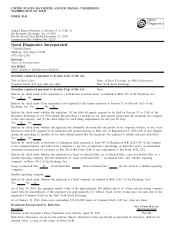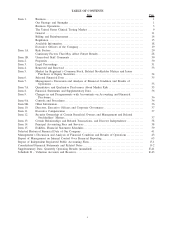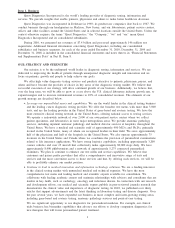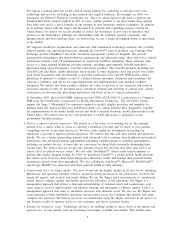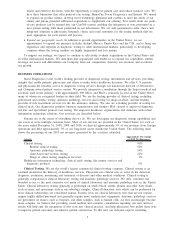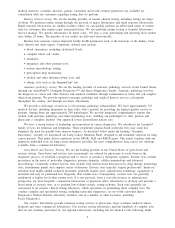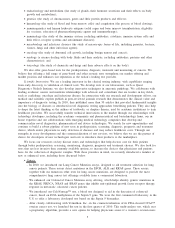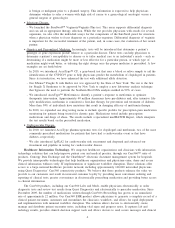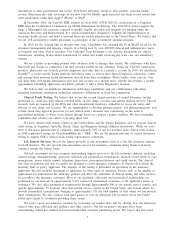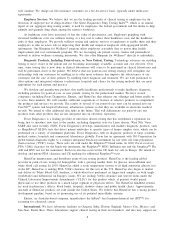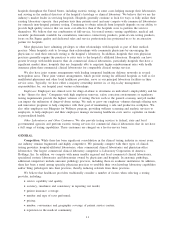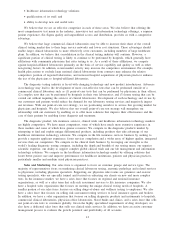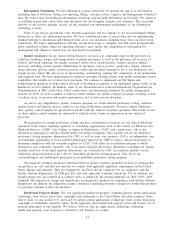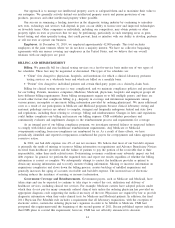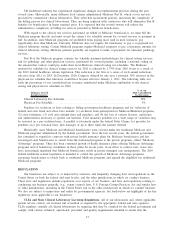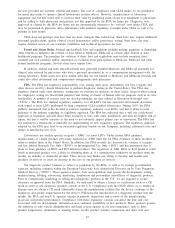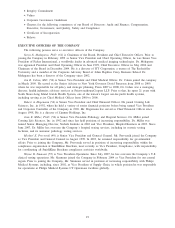Quest Diagnostics 2010 Annual Report Download - page 12
Download and view the complete annual report
Please find page 12 of the 2010 Quest Diagnostics annual report below. You can navigate through the pages in the report by either clicking on the pages listed below, or by using the keyword search tool below to find specific information within the annual report.clinical trials business. We have an office in Ireland that supports our activities in that country, and also have
sales representatives dedicated to offering our point-of-care test products in countries outside the United States.
We see opportunities to bring our experience and expertise in diagnostic testing and point-of-care products to
international markets, particularly developing countries where the testing markets are highly fragmented and less
mature, including by leveraging existing facilities to serve new markets.
THE UNITED STATES CLINICAL TESTING MARKET
Most clinical tests are performed by one of three types of laboratories: hospital-affiliated laboratories;
commercial clinical laboratories; or physician-office laboratories. We believe that hospital-affiliated laboratories
account for approximately 60% of the market, commercial clinical laboratories approximately one-third and
physician-office laboratories the balance.
Key Trends. There are a number of key trends that we expect to have a significant impact on the clinical
testing business in the United States and on our business. These trends present both opportunities and risks.
However, because clinical testing is an essential healthcare service and because of the key trends discussed
below, we believe that the industry will continue to grow over the long term and that we are well positioned to
benefit from the long-term growth expected in the industry.
Demographics. The growing and aging population is increasing the demand for clinical testing.
Prevention and wellness. We believe that the value of detection, prevention, wellness and personalized care
is recognized more now than ever before. Consumers, employers, health plans and government agencies
increasingly are focusing on helping the healthy stay healthy, detecting symptoms among those at risk and
providing preventative care that helps avoid disease. Physicians increasingly are relying on diagnostic testing to
help identify risk for a disease, to detect the symptoms of disease earlier, to aid in the choice of therapeutic
regimen, to monitor patient compliance and to evaluate treatment results. Physicians, consumers and payers
increasingly recognize the value of diagnostic testing as a means to improve health and reduce the overall cost of
healthcare through early detection, prevention and treatment. Federal healthcare reform legislation adopted in
2010 contained provisions eliminating patient cost-sharing for preventative services, and additional provisions that
we believe will increase the number of patients that have health insurance and thus better access to diagnostic
testing.
Science and technology advances. Medical advances allow for more accurate and earlier diagnosis and
treatment of diseases. Continuing research and development in the area of genomics is expected to yield new,
more sophisticated and specialized diagnostic tests. These advances also are spurring interest in and demand for
personalized or tailored medicine, which relies on diagnostic and prognostic testing. Pharmacogenomic testing
increasingly is used as a parameter to help speed drug approval processes and to better focus therapy based on
patient and tumor-specific genetic markers. Demand also is growing toward comprehensive care management
solutions that serve patients, payers and practitioners by improving access to patient data, increasing patient
participation in care management, reducing medical errors and improving clinical outcomes. There is an
increasing focus on interconnectivity, and electronic medical records and patient health records continue to grow.
Customers and payers. Our customers and payers, including physicians, health insurance plans, employers,
pharmaceutical companies and others, have been consolidating. We expect that this trend will continue.
Consolidation is increasing bargaining power, enhancing purchasing sophistication and encouraging internalization
of testing. In addition, federal healthcare reform legislation adopted in 2010 encourages the formation of
“accountable care organizations” and requires implementation of health insurance exchanges, which may result in
changes in the way that some healthcare services are purchased and delivered in the United States.
Competition. The clinical testing industry remains fragmented, is highly competitive and is subject to new
competition. Competition is growing from non-traditional competitors. Increased hospital acquisitions of physician
practices enhance physician ties to hospital-affiliated laboratories and may strengthen their competitive position.
New market entrants with extensive resources may make acquisitions or expand into our traditional areas of
operations. We also are expanding into new diagnostic testing areas that are highly competitive.
Legislative, regulatory and policy environment. Government oversight of and attention to the healthcare
industry in the United States is significant and increasing. The 2009 American Recovery and Reinvestment Act
included laws designed to expedite the implementation of electronic health records and build a national electronic
health infrastructure in the United States. During 2010, the FDA publicly announced that it has decided to
exercise regulatory authority over laboratory developed tests, and that it plans to issue guidance to the industry
regarding its regulatory approach. Federal healthcare reform legislation adopted in 2010 has created significant
uncertainty as healthcare markets react to potential and impending changes.
9


